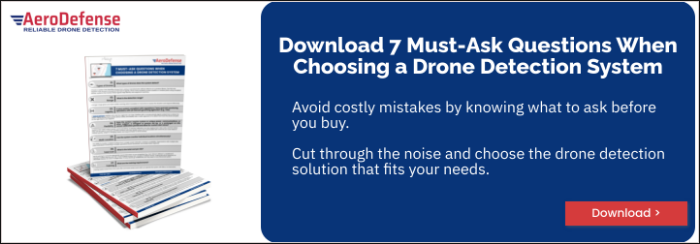Summary: Choosing a drone detection system?
When choosing a drone detection system, it’s vital to ask key questions about what types of drones it detects, its detection range, regulatory compliance, deployment flexibility, scalability across multiple sites, and total cost per location.
The right drone detection system aligns with your environment—whether you need a lightweight Remote ID receiver for most drone use-cases or a layered solution for higher-risk scenarios.
By matching your operational needs, legal constraints, and budget, you can choose a system that delivers real airspace visibility without unnecessary complexity.
Ask 7 key questions to find a legal, cost-effective solution that fits your airspace security and tracking needs.
Choosing a drone detection system is an important step in knowing what’s in your airspace and keeping it safe. With more drones flying, you need a system that fits your needs. By asking the right questions, you can find the best option for detecting drones, tracking pilots, and keeping your site secure.
For More on Choosing the Right Drone Detection System, Here are 7 Must-Ask Questions:
What types of drones does the system detect?
Choose a system that identifies drones from various manufacturers without reliance on a product library. The FAA now requires most drones to broadcast Remote ID signals. Since many incidents involve clueless or careless pilots using compliant drones, systems that receive these signals help identify and respond in real time.
What is the detection range?
A longer range gives your team earlier warning, which translates to more time to assess the situation and respond effectively.
Is your system compliant with regulations/laws and UAS monitoring operations with all relevant governing agencies? (E.g., FAA)
A federal advisory explains why only four agencies can stop, interfere with, or access private signal content from a drone. For others, taking drones down poses serious safety and liability risks. A safer approach is to detect and track the drone and pilot so the right teams can respond.
Does the system require custom or unique power, communications, or other support, a stringent or precise set-up, or a prolonged on-site sensor calibration period, and allow for custom alert zones?
Systems that need custom power, communications, or precise calibration can slow deployment, raise costs, and limit where they can be used. In contrast, portable solutions with fast, flexible setup and customizable alert zones let you cover areas of interest quickly, adapt to changing needs, and respond faster to drone activity.
Can the system monitor individual locations simultaneously?
The ability to monitor multiple locations from a single screen indicates a solution’s scalability. Organizations with multiple sites need centralized monitoring to simplify operations, boost awareness, and enable faster response.
What is the total cost per site?
Ask for pricing to cover the appropriate square kilometers of your properties (E.g., 1 km, 100 km, 1000 km, or 10,000 km). Choose a system that fits your risk—most incidents involve FAA-compliant hobbyist drones, making Remote ID detection an affordable solution for one or multiple sites. If many drones go undetected, you may need a more advanced system.
What are the training requirements?
Training needs reveal if first-time users, like command center event staff, can operate the system with little or no instruction.
Choosing a drone detection system isn’t a one-size-fits-all decision. By asking these key questions, you can find a solution that fits your security needs, budget, and long-term goals. Whether you need basic Remote ID monitoring or a more advanced system, the right choice will help you stay ahead of potential threats.
You can also learn more by reading our Ultimate Guide to Drone Detection.
Choosing a Drone Detection System FAQs
What detection capabilities should I prioritize in a drone detection system?
You should look for systems that:
- Detect a broad range of drones (various manufacturers). (AeroDefense Blog)
- Receive and interpret FAA Remote ID broadcasts, which help locate the pilot.
- Provide sufficient range to detect drones early — giving you more time to assess intent and respond.
How important are legal and regulatory considerations when selecting a system?
Very important: drone-detection/mitigation technologies fall under federal regulations (e.g., communications interception laws, mitigation authority). If the system decodes private signals or attempts to interfere with drones, it may require special waivers.
For most organizations, a system that passively receives Remote ID signals is legally safer. (AeroDefense).
What kind of deployment flexibility should I look for?
Depending on your scenario, you might need:
- A fixed, always-on installation (for critical infrastructure).
- A portable/rapid-deploy solution (for events, temporary coverage).
- A system offering both fixed and mobile configurations gives you adaptability.
If I operate multiple sites, what should I ask for?
For multi-site operations:
- A unified dashboard or interface that monitors all sites centrally.
- The ability to scale sensor deployment across locations without each site becoming a standalone silo.
- Consistent alerting, reporting, and control across sites.
What about cost and operational impact?
Key cost factors include:
- Total cost per site (hardware, licensing, maintenance).
- Training required for staff to operate the system effectively.
- Hidden or ongoing costs (software updates, sensor replacement, site maintenance).
How do I match system complexity with my actual threat level?
If your site typically experiences hobby-drones (compliant with Remote ID) or only occasional drone activity, a Remote ID receiver-based system is probably sufficient.
If you face higher-risk threats (non-compliant drones, payload delivery, espionage), then you may need a more sophisticated layered system. Feel free to reach out for a consultation.

